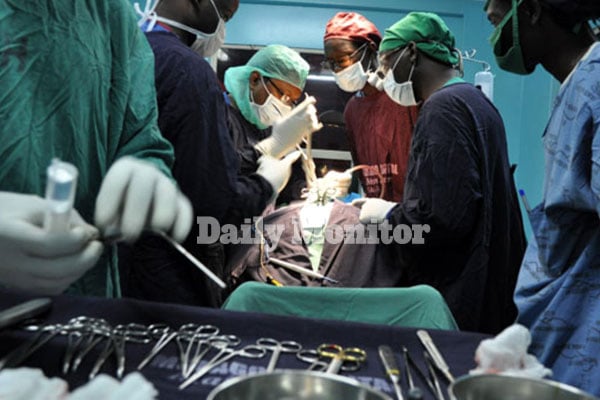Rise in caesarean deliveries and the danger we overlook

Procedure. Surgeons carry out a caesarean operation at Mulago hospital. Caesarian section births have increased. PHOTO | RACHEL MABALA
A C-section or Caesarean section often termed as “Cesar” in society is a type of surgery used to deliver a baby. The baby is surgically removed through an incision made in the mother’s abdomen and then a second incision in the uterus medically termed as a cresenteric incision made on the lower uterine segment.
The baby is taken out through the mother’s abdomen followed by the placenta and membranes delivered by controlled cord traction (CCT). The uterus and abdomen are repaired in layers using various suturing techniques and material. Most cesarean births result in healthy babies and mothers, but the c-section, being a major surgery, carries risks and healing also takes longer than with a vaginal birth.
Caesarean section or delivery, is the surgical procedure often performed when vaginal delivery would put the life of baby, mother or both at risk.
There are two major types of incisions made on the abdomen during a c-section. The classical incision made vertically, medically termed as sub umbilical mid incision (SUMI) often reserved for more complicated situations such as placenta previa, babies with abnormalities and other emergencies.
However, vaginal birth after cesarean (VBAC) is not recommended for women that had a classical incision made. The other incision is a bikini cut, often called the pfannenstiel incision, more popular because it heals and looks better not to mention causing less pain after surgery.
The Caesarean section is named after the Great Julius Caesar, a name actually derived from the Latin word “caedare,” which means “to cut.” While the exact timeline is debatable, the University of Washington reports that some believe Caesar was the first to be born via a C-section, but while Caesar still gets credit for the name, several historians believe that the C-section was used way back before his time. It was primarily used to help deliver babies whose mothers were dying or died from birth. Because of this, no narratives exist from mothers who had C-sections before the 1500s. Despite the disheartening circumstances, there was a thick deal of optimism surrounding babies born via C-section. According to the University of Washington, it is on record that such babies were believed to have great strength and mystical powers that made them Greek gods. Adonis wasn’t an exception and is believed to have been born through C-section around the 1500s.
Perhaps the first written record we have of a mother and baby surviving a caesarean section comes from Switzerland in 1500 when a Sow Gelder, Jacob Nufer, performed the operation on his wife after several days in labour and help from 13 midwives, the woman was still unable to deliver her baby. The first recorded successful cesarean in the British Empire, however, was conducted by a woman. Sometime between 1815 and 1821, James Miranda Stuart Barry performed the operation while masquerading as a man and serving as a physician to the British army in South Africa not to mention several sources that point out a successful Caesarean section performed by indigenous healers in Kahura, Uganda.
The ‘medicine men’ and experienced surgeons of the Bunyoro-Kitara Kingdom carried out advanced level infection-free C-section.
Kenneth Talemwa,




